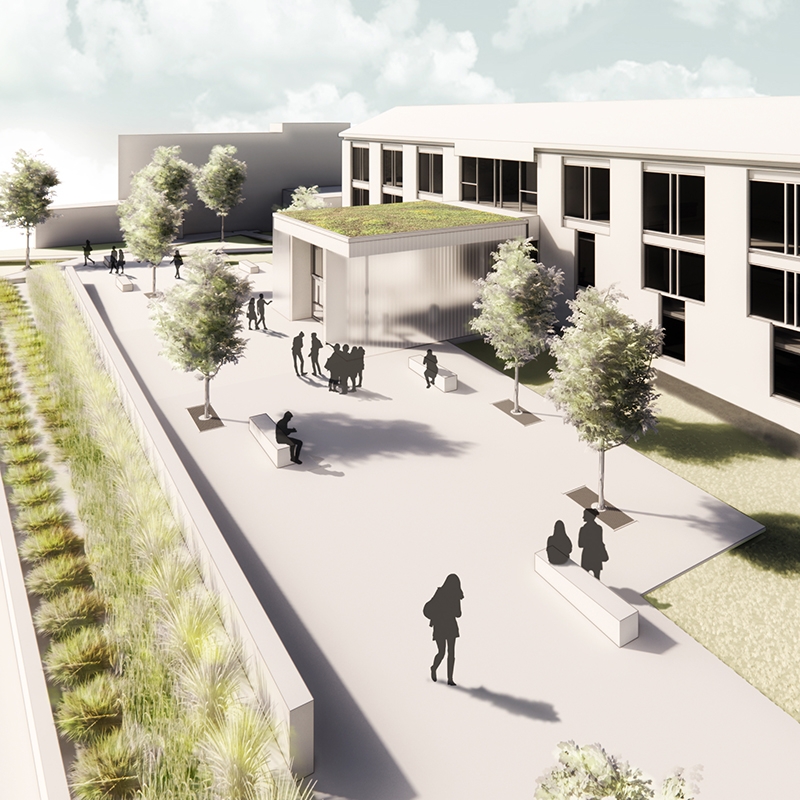Middlebury Receives $10 Million Gift to Enhance the Arts

An anonymous donor has made a $10 million gift to renovate the Christian A. Johnson Memorial Building—home to Middlebury College’s Architectural Studies Program and Department of Studio Art—and to advance planning for a new museum that would join with Johnson and Wright Theatre to form an arts quadrangle on the north side of campus.
The gift will enhance one of Middlebury’s most significant buildings, preserving its distinctive architectural details and improving its accessibility, energy efficiency, and overall state of repair. It will also fund a program study for a proposed new museum.
“For more than half a century, the Johnson Building has enriched the lives of students, faculty, staff, and the greater Middlebury College community,” says President Laurie L. Patton. “We are thrilled to receive this gift, which will renovate the building for a new generation and inspire students and faculty to do bold, creative work.”
“The timing coincides with our plans to return the College’s art collection to the central campus. The program study will ensure the new museum will be an exceptional teaching museum, embedding the arts into the curriculum across College departments. And the museum will do even more—together with Johnson and Wright Theatre—it will form a public square that inspires human expression. We are profoundly grateful for the donor’s generous support.”
The new museum will be built near the current site of Battell Hall, a first-year residence hall on the north side of campus. Battell will be replaced with a new residence hall nearby, with construction beginning in one to three years.
“Taken together, the renovation of the Johnson Memorial Building and the plan for a new museum make a statement about the centrality of the arts in the intellectual and emotional development of the College’s students—and indeed all humans,” the anonymous donor says. “In addition, the arts quadrangle could become a central meeting ground for debate, outdoor performances, and other special events.”
Renovating Johnson for a New Generation
Completed in 1968, the Johnson Building was designed as an interdisciplinary center for the fine arts and music departments and a place in which artistic collaboration would naturally percolate. As such, it included classroom space and faculty offices for art history and music, studios for the creation of art works, listening and practice rooms for music, and a concert hall with organ for chamber music performances. Additionally, the building featured the first dedicated art gallery on campus and a core exhibition space for student works, along with an elegant gathering area for receptions of all kinds. Eventually, the subsequent flowering of the arts at Middlebury caused the need for additional space, resulting in changes in programming within the building. Now, after more than half a century of intensive use and programming changes, the building requires a substantial renovation.
Designs prepared by Associate Professor of Architecture John McLeod, principal at McLeod Kredell Architects, are in the works with a team of engineers and specialists, and renovations will begin next summer. The plan is for work to be completed in time for the opening of the fall 2023 semester. McLeod has taught Architectural Studies students in the building for many years, so he is well aware of both the positive features and the current limitations of the building.
McLeod notes that while Johnson is architecturally important and an excellent teaching tool for his students, “the building as designed in the mid-’60s was not focused on accessibility or energy efficiency. Life-safety codes have become more stringent in the last 50 years. The users and uses of the building have changed. And after 50 years of varied use, including production-heavy arts disciplines, the physical fabric of the building needs repair, cleaning, and select replacement.”
The design proposed by McLeod Kredell Architects comes as close as possible to providing universal access to and through the building and makes the building easier to understand and navigate for all users. Key elements of the renovation plans include:
- A new, graded plaza, which will provide access to the main entrance of the building from handicap drop-off/parking and sidewalk approaches from various directions. This will allow everyone to come and go through the primary entrance if they desire, regardless of physical ability.
- A glass-enclosed entry pavilion, which will offer an elegant light-filled arrival space that provides display opportunities for student and professional works and will make a statement about the nature of the building.
- New open stairs and an elevator from the lobby, which will provide direct access from the main entrance to the primary floor levels and major public spaces of the building.
- Upgraded building envelope and systems.
- A reconfiguration of the existing floorplan, which will provide much-needed flexible space for Studio Art and Architectural Studies.
A Brutalist Master Work
The Johnson Building is one of the most architecturally significant buildings on the campus and one of a handful of buildings that were conceived not only to suit very particular functional programs, but also to serve as total works of art, according to Professor Emeritus of History of Art and Architecture Glenn Andres. It was designed by Jean Paul Carlhian of the Boston firm Shepley Bulfinch Richardson and Abbott in the Brutalist style, and the architect considered it one of the finest designs of his career, Andres notes.
“Good Brutalism has gritty integrity, intellectual and communicative strength, and discipline,” Andres says. “Carlhian produced a powerful material lesson in how architecture is made. Generations of students have discovered that Johnson just gets richer the more closely it is analyzed. The Johnson Building is remarkable for surviving almost fully intact to speak of this significant moment in American architecture, and we are fortunate to have this prime and refined example of Brutalism in our midst.”

